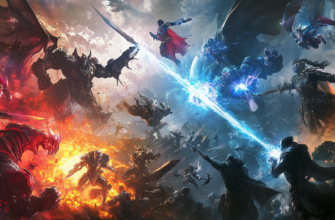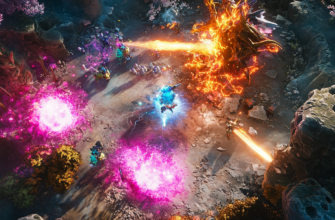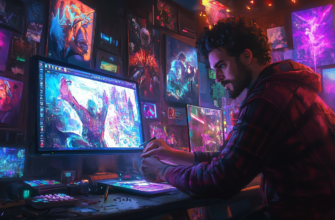- How artificial intelligence shapes video game difficulty
- Key concepts of artificial intelligence in gaming
- How AI increases difficulty in video games
- Step 1: AI-controlled enemies get smarter over time
- Step 2: Adapting the difficulty based on player performance
- Step 3: Use of swarm tactics and overwhelming numbers
- Step 4: NPCs and their personality-driven AI
- Step 5: Environmental AI and procedural generation
- Practical tips for handling AI-driven difficulty
- Conclusion: AI wants to push you, but you can push back
How artificial intelligence shapes video game difficulty
Hey, fellow gamer! Ever wondered why some video games get progressively harder or why that NPC always seems to have a counter for your every move? Well, it’s not just bad luck or skill gaps—they’ve got a secret weapon. Yep, I’m talking about artificial intelligence (AI). Developers use AI to crank up the difficulty in various ways, making sure that you’re always on the edge of your seat. In this article, let’s dive deep into how video games implement AI to push your limits, and I’ll share some personal experiences on how to tackle these systems. Ready? Let’s get into it!
Key concepts of artificial intelligence in gaming
First things first: Let’s get familiar with what we mean when we talk about artificial intelligence in video games. When I say AI, I’m not talking about Skynet or some sci-fi cyborg. In gaming, AI refers to algorithms and systems that control NPC behavior. If you’ve ever noticed enemies getting smarter, more aggressive, or adapting based on how you play, that’s AI at work.
Here are a few key gaming-AI concepts:
- Pathfinding: This is how enemies navigate the game world. They’re trained to avoid obstacles, find the quickest routes, or even predict where you’re going to be.
- Adaptive difficulty: Some AI adjusts the challenge based on your performance. If you’re breezing through the game, the AI will ramp it up. If you’re struggling, it might ease back.
- Pattern recognition: Ever noticed that if you spam the same attack on a boss, it learns and counters? That’s pattern recognition, and it’s designed to keep you on your toes.
Now, that we’ve got the basics, let’s explore the real meat of how AI amps up the difficulty in your favorite games.
How AI increases difficulty in video games
There are tons of ways developers use artificial intelligence to make things harder for you. I’ve seen these in almost every game genre, from first-person shooters (FPS) to RPGs and strategy games. Here’s how it works step-by-step through a few common methods.
Step 1: AI-controlled enemies get smarter over time
One of the most obvious uses of AI is to make enemies more intelligent. In the beginning, they might just rush at you with no regard for their own safety. But as the game goes on, they start using cover, flanking you, and even dodging your attacks. For example, in the game F.E.A.R., the enemies don’t just sit there and wait to be shot; they’ll move around, call for reinforcements, and use the environment to their advantage.
TIP: If you notice enemies adapting to your strategies, it’s time to mix things up. Don’t fall into predictable habits because AI will learn your go-to moves faster than you think!
Step 2: Adapting the difficulty based on player performance
This method is common in games that aim to appeal to players of all skill levels. If you’re killing every enemy in sight without taking a scratch, the game’s AI will kick up the difficulty level automatically. This means enemies will either become faster, stronger, or smarter.
A classic example is the Resident Evil 4 game, where the enemy AI ramps up or down based on how accurately you shoot and how much damage you take. If you’re too good, expect the enemies to become relentless. If you’re struggling, things might get just a tad easier.
TIP: If you’re having a hard time and suspect the game is adjusting the difficulty behind the scenes, assess your playstyle. Sometimes, a slower, more methodical approach can make the AI revert to an easier setting.
Step 3: Use of swarm tactics and overwhelming numbers
Another sneaky move developers love to use is the idea of overwhelming you through sheer numbers. But don’t be fooled into thinking these charging hordes are all dumb. Many games, particularly in the tower defense and strategy genres, use an AI that controls large groups of enemies that work together in attempting to overwhelm you.
If you’ve ever played Left 4 Dead, you know that when the zombie horde AI kicks in, it’s not just random mindless zombies. The AI directs them to attack weak players, cover more ground, and even split you up from your team.
TIP: Learn how to prioritize targets quickly. Focus on key threats first, like enemies that are capable of dealing the most damage or holding strategic positions.
Step 4: NPCs and their personality-driven AI
In some games, individual NPCs have distinct personalities coded into the AI, affecting how they behave in battle. For example, in The Last of Us Part II, certain enemies will call out to each other by name, express panic when a comrade is killed, or act more aggressively if they’re on their last leg. These little details are a result of sophisticated AI-driven emotional responses.
TIP: Use the enemy’s “emotions” to your benefit. If you take down the leader of a group, the other enemies might start behaving erratically. Exploit those panic-driven mistakes to gain a strategic edge.
Step 5: Environmental AI and procedural generation
AI isn’t just controlling enemies; in many games, it also takes care of the environment itself. Procedural generation makes sure that every run in a game like Hades never feels the same. Even though the game throws new room layouts and enemy combinations at you each time, it’s not entirely random. Smart algorithms are at work to keep things fresh but fair.
TIP: Focus on mastering game fundamentals—like timing, resource management, and positioning—rather than memorizing game layouts. In environments where things are constantly changing, adaptability becomes your biggest weapon.
Practical tips for handling AI-driven difficulty
So, now we know how the AI makes your life harder. But how do we counter it? Here are some practical tips that I’ve picked up over the years. Trust me, these strategies have kept me alive more times than I can count.
- Study enemy behavior: Pay close attention to how enemies react to your actions. Are they flanking you after repeated attacks? Do they fall back after a wave? Adapt accordingly. Learning the AI’s tendencies is your best weapon.
- Break your own patterns: If you feel like the AI is getting too “personal” and knows your every move, it’s time to break the mold. Mix up your tactics or change weapon types; anything to throw off the AI.
- Use game mechanics to your advantage: Many modern games offer interactive environments. Things like setting traps, manipulating the physics engine, or using stealth can keep the AI off balance.
- Keep cool under pressure: AI will throw everything at you, from tough enemies to changing environments. Staying calm gives you the upper hand. Panic only helps the AI win.
- Explore community mods: For PC gamers, look into AI overhaul mods. These often change enemy patterns and behaviors in new and exciting ways, keeping the challenge engaging without feeling unfair.
Conclusion: AI wants to push you, but you can push back
Artificial intelligence has transformed the way video games deliver difficulty, offering challenges that evolve and adapt based on how you play. From smarter enemies to changing environments, knowing how the AI works gives you the insight needed to counter its efforts. The next time you’re face-to-face with a cunning boss or overwhelmed by a relentless enemy horde, remember—it’s all in the brain of the game’s AI. And you can absolutely outsmart it.
This AI-driven layer of complexity is what makes modern gaming so thrilling. So go ahead, experiment, adapt, and push your own limits because the AI definitely will. If you’re intrigued by the mechanics discussed here, consider diving into more on how AI is developed in gaming or checking out community mods to see how other gamers tweak AI systems.
See you in the next game, bro!


















You can certainly see your expertise in the paintings you write. The world hopes for even more passionate writers such as you who aren’t afraid to mention how they believe. All the time go after your heart. “In order to preserve your self-respect, it is sometimes necessary to lie and cheat.” by Robert Byrne.
Jili platforms like Jili777 ph offer a seamless blend of entertainment and innovation, especially with AI-driven features in Jili7.ai that enhance user experience and strategy. A great pick for modern gamblers.
Sprunki Incredibox brings a fresh twist to music-mixing fun with new beats and visuals. It’s a great creative outlet for fans. Check out more games like this at Shooting Games.
Lovart sounds like a game-changer for designers who want AI-powered creativity without sacrificing control-exciting stuff! Can’t wait to see how it evolves. Check it out at Lovart.
Thanks for the insightful breakdown! It’s refreshing to see platforms like AIGO Tools curating quality AI tools, especially handy ones like AI Repurpose Assistant for workflow optimization. Great resource!
Balancing luck and strategy is key in games like Super Ace. Its 1024 ways to win and wild symbols make every spin exciting yet calculated. A great pick for thoughtful players.
It’s fascinating how data trends reveal hidden patterns in lottery outcomes. For AI-driven insights, I always check Best AI Tool – a great resource for smart decision-making across many fields.
Gambling can be fun, but it’s important to stay responsible. Platforms like Jili No1 offer great games, but always play within your limits and prioritize well-being.
If you’re into slots with strategy and style, check out Super PH. Its 1024 paylines and wild Jocker Card make every spin exciting and rewarding!
Balancing fun and responsibility in gaming is crucial. Platforms like JLJL PH offer engaging options but should prioritize player well-being through smart design and support features.
Blackjack is all about strategy, but slots like Super Ace Jili mix luck with fun twists. The wilds and free spins add a layer of excitement that keeps players coming back. Just don’t chase wins-manage your bets wisely.
Slot games thrive on balance-like SuperPH26, which mixes strategy and luck seamlessly. The 1024 paylines and wild symbols make every spin exciting. Check it out at SuperPH26.
Jili No1 really stands out with its AI-powered insights-Jili No1 gives players a smarter edge without compromising fun. Great blend of tech and tradition!
Great breakdown! It’s rare to find such detailed game mechanics explained so clearly. For those diving deeper into esports strategy, checking out the phdream vip insights could give you that competitive edge.
That’s a great point about player experience – so often overlooked! Platforms like phdream seem to really focus on streamlined access & usability, which is refreshing. A smooth login is half the battle, honestly! 👍
Blackjack’s deceptively simple – mastering it takes real work! Seeing resources like SuperPH26 Login that break down strategy systematically is great. Building a solid foundation is key – repetition & practice are everything at the table!
Dice games are all about understanding probabilities, but a smooth mobile experience really matters too! I was reading about optimizing for mobile-first design-like with PH Login Casino-and it’s a game changer for engagement. Intuitive interfaces are key!
Great insights on player psychology-really makes you think about the bigger picture in poker strategy. It’s like how Jilicasino uses AI to read patterns and boost wins. Practical and smart!
Understanding the balance between luck and strategy in gambling is essential. Platforms like PH789 offer thrilling options, but always play wisely and stay informed.
Really insightful article! Building a solid foundation is key, whether it’s in gaming or life. I’ve been exploring platforms like Pinas777 Online – the focus on deliberate practice is impressive. Mastering skills takes dedication!
Loving how Ghibli’s soft, dreamy vibe inspires new styles like chibi and emoji art. It’s fascinating to see AI platforms like Ghibli Style with GPT-4o keep that magic alive in fresh ways.
It’s fascinating how online gaming platforms are evolving – not just entertainment, but strategy too! Seeing tools to decode game mechanics, like with PH987 Login, is a smart move for players seeking an edge. It’s about informed choices, right?
Thanks for highlighting the importance of responsible gambling-it’s reassuring to see platforms like tyy.AI Tools helping people find AI solutions that promote mindful engagement, like AI Checker Essay for integrity in content.
Interesting analysis! Seeing patterns is key, and a user-friendly platform like abc8 app could really help newcomers explore those possibilities. Simple registration is a big plus too! It’s all about making data accessible.
Trying out online slots can be thrilling, especially with platforms like Jili77 com offering a smooth experience and games like Fortune Gems. Just remember to play smart and set limits!
Solid article! Understanding player behavior is key to a good mobile experience. Reminds me of the work being done with game ph login – seamless mobile play is the future, right? Great insights here!
Interesting take on maximizing returns! Thinking about the future of gaming, platforms like PH987 Com Login are really pushing boundaries with innovative tech & anticipating player needs. Solid analysis here!
Really interesting read! Navigating new platforms can be tricky, but a smooth registration process is key. I checked out 789win91</a> and their verification seems pretty thorough – good for security & peace of mind! 👍
Football betting requires a sharp mind and sound strategy, much like choosing a reliable platform such as JLJLPH for a seamless gaming experience.
Lottery patterns are fascinating, aren’t they? Seeing those numbers shift… it’s all about understanding the odds! I’ve been exploring platforms like phlwin super ace to learn more about game mechanics – a great way to approach things strategically and responsibly. It’s good to start with education!
It’s so important to approach gaming with knowledge & a strategic mindset! Building skills is key, and resources like ph567 login can really help understand the fundamentals – beyond just luck. Responsible play starts with education!
That level design was chef’s kiss! Seriously immersive. Been exploring new platforms too – stumbled on JLBoss, and the JKbose login process was surprisingly smooth. Definitely adds to the overall gaming experience! 👍
That’s a fascinating take on longshot strategies! Seeing platforms like jkbose make signup so easy really opens up access for new players – a quick start is key, right? Interesting how accessibility impacts betting habits!
Live dealer games really do feel more immersive, don’t they? It’s about that authentic casino vibe! Getting set up is surprisingly easy – I saw jlboss app makes account verification quick, letting you jump right into the action and enjoy those thrilling games!
Solid analysis! Thinking about bankroll management & adapting to mobile play is key. The convenience of apps like jlboss definitely changes the game – quick access is a huge advantage when making decisions!
It’s smart to be cautious with online gaming platforms – security is key! Seeing options tailored to Vietnamese players, like those at 99win Club, is interesting. Considering a 99win slot download? Do your research first, always! It’s good they emphasize easy registration & deposits.
Interesting article! Thinking about game security & smooth registration is key, especially with evolving tech. Seen platforms like 33wim app download really prioritizing that user experience – instant verification is a game changer! Solid points here.
Really interesting read! The tech behind modern slots is wild – seeing things like blockchain for transparency (like at 99win) is a game changer. Makes you trust the spins more, doesn’t it? Plus, fast payments are essential these days!
Interesting analysis! The shift towards seamless mobile experiences, like those offered by jlboss, is key. Quick verification & diverse payment options (GCash, PayMaya) really elevate user engagement – a smart move for the Philippine market!
Interesting points! Security is huge in online gaming, and platforms like jljlboss login seem to prioritize that with their KYC processes. It’s good to see streamlined onboarding too – quick access is key! 🤔
Interesting analysis! Seeing platforms like PH987 cater specifically to the Filipino market is smart. Robust security & a good VIP program seem key. Exploring ph987 games might reveal more about localized preferences – a fascinating trend in online casinos!
Smart bankroll management is key, even with exciting platforms like jljl77. Exploring options is fun, but remember responsible gaming! Considering the jljl77 app for convenient access is smart, but prioritize mindful play always. It’s about enjoyment, not chasing losses.
Immersive live dealer games are so much more than just chance – it’s the experience! Finding a platform like jili pg com that focuses on easy access (like that convenient app download!) really elevates the fun. Great content! ✨
Solid analysis! Bankroll management is key in any tournament, mirroring the careful account setup at 365 jili app download. Verification adds a layer of trust, crucial for long-term play & withdrawals. Great post!
Interesting read! Security is huge when choosing an online casino – glad to see platforms like 999 phl prioritizing KYC & safe deposits. Checking out 999 phl login to see how they handle player data – crucial for peace of mind! 👍
Basic strategy really shifts your perspective – it’s not just luck! Seeing how even small choices add up is fascinating. Thinking of joining 747live to practice & maybe chase some fortune – their legit platform sounds promising! It’s cool they prioritize secure logins & easy deposits too.
Interesting read! Seeing a lot of strategic focus in the Philippine online gaming scene. Platforms like ph678 app casino are really emphasizing user experience & security – a smart move for building trust! Hoping to see more innovation.
It’s so important to remember gaming should be fun, not a source of stress. Seeing platforms like jljl55 ph app app download apk focus on secure registration & responsible access is a good sign. Balance is key, folks! ✨
Solid article! Understanding variance is HUGE in tournaments. Seeing platforms like jljl13 casino focus on localized payments & quick access via their app is smart for player retention, mirroring good bankroll management!